Timber Framing Course at Rancho Mastatal
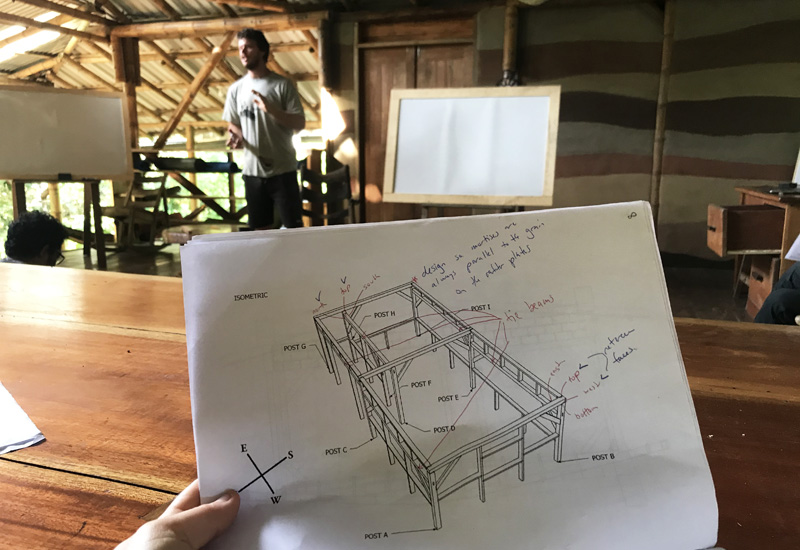
I’ve just finished up two weeks in Costa Rica spending a week each on two very different building courses. The second course was a challenging week learning about bamboo (which I’ll write about later) and the first course was on timber framing and held at Rancho Mastatal – it was one of the best courses I’ve ever taken!
Rancho Mastatal is a small community located a few hours outside of San Jose, Costa Rica. Their rural setting is beautiful and it’s very easy to settle in with the rhythm of life there. They have six core community members, local staff, apprentices who commit to being there for a year, interns who stay for two months at a time, guests, and they often host courses. The place is a hive of activity with lots of different types of people buzzing around and it feels like how I imagine a successful community should. Everyone seems happy and laid back and everything ran very smoothly during my time there. I know there’s a lot of behind-the-scenes work that goes into running courses and hosting guests and they nailed it!
Rancho Mastatal aims to ‘provide powerful educational opportunities through our inspirational, experiential programs and onsite network of integrated, working systems’ and, based on what I experienced in my short week there, they’re doing an amazing job. They have a great selection of courses held throughout the year, they run a really awesome apprenticeship programme, a shorter internship programme, and they have lots of people coming through as guests. Just as I was leaving, a group of students doing EMT training for tropical environments arrived and they also host local student groups and I’m sure they have many more people passing through for interesting educational opportunities. It’s a place that seems to attract excellent people and I had some really great conversations while I was there.
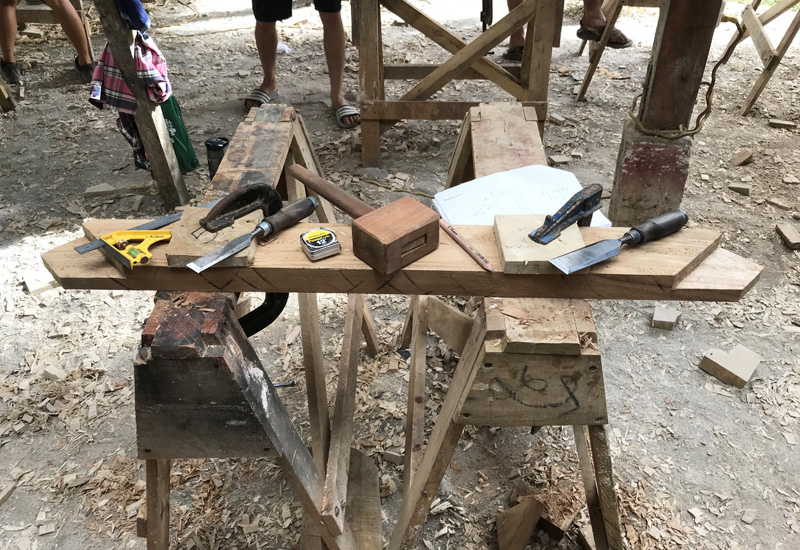
But enough gushing about El Rancho… lets talk timber! The course was taught primarily by Nic with the support of Ali – both core members of the Rancho Mastatal team. It started the evening we arrived with an amazing meal and some introductions. Then the next day we had some classroom time and a tour of the beautiful buildings on the ranch. I think I first learned about Rancho Mastatal through a YouTube video giving a tour of their buildings. The video was quite remarkable and the buildings were even more beautiful in person.
I love Nic’s mentality on building. He sees buildings as serving as much more than just a functional purpose and speaks about the process in a way that really resonates with me. He seems to have been given a lot of freedom to design and build in his own style and at a pace that makes things enjoyable for him and any students that help out. I understand that budgets and timelines don’t always permit people to take their time when building, but the idea of rushing through a structure just to get it done to a mediocre standard fills me with anxiety. I think that natural building offers such an amazing opportunity for beauty as well as functionality and Nic and Ali and everyone else who has helped with their buildings have done an amazing job of accomplishing both.
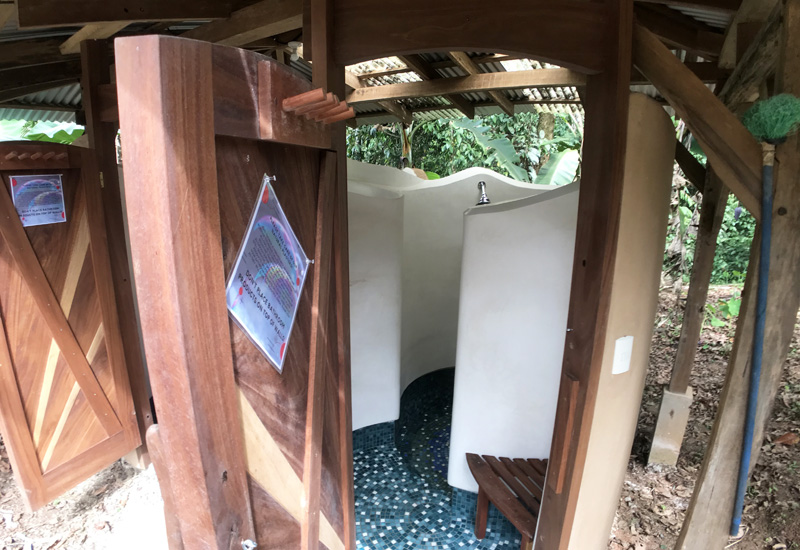
Ok so enough gushing about the buildings… back to the timber! We started each day bright and early at 7am, the first three days starting with an hour of classroom time. On day one we were taught the Square Rule method of timber framing. One of the great mysteries of timber framing was how to work with timber that’s not square, but this class explained it all away. It’s a remarkably logical and simple method once you grasp the main concepts. I loved that we were given this level of detailed information and then asked to lay out our own timbers using this new knowledge. This is exactly how I learn best – being taught a concept, trying it, making mistakes, asking for help, correcting, and eventually perfecting it.
Once we had this basic layout knowledge, we all ended up with our own post or beam to work on. We had a printed package of the plans along with some theory and best practice and it was our job to work out how to lay out our individual piece of timber based on the plans, each at our own pace and with our own unique challenges. Some people had to spend a lot of time planing their wood to square and others were able to dive right into laying out. Ali and Nic were there to answer questions and eventually, after several hours of work, they checked everything and we were able to start working with the tools.
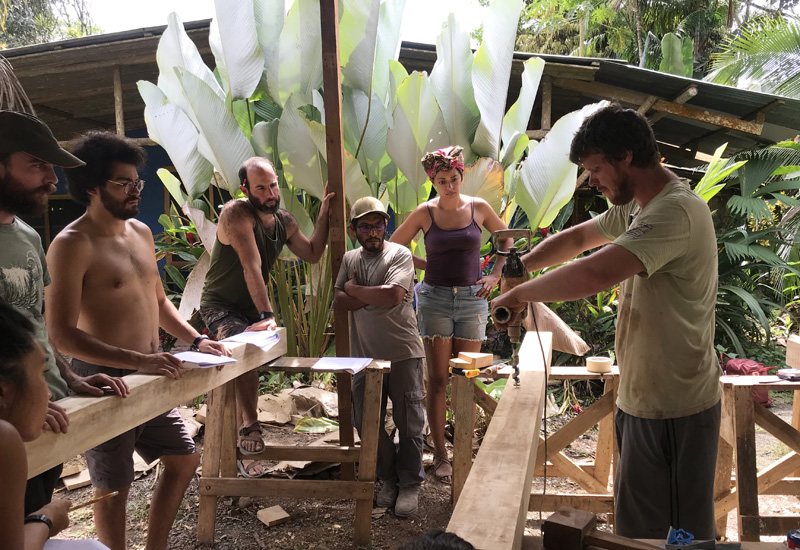
I thought it was really great how they structured the course. We were all working independently on a project that would come together as a whole. With each of us doing our own thing, we were all fully engaged and very into it and even spent our lunches and dinners partially chatting about the exciting world of laying out and cutting timbers. I know that I felt ownership over my timber and pride in the work I was assigned to do and I’m sure the other students felt the same way.
We were all working at a different pace but Nic structured things so that nobody was ever standing around with nothing to do. As the first student completed their task and needed to move onto a next step (sawing, chiseling, drilling, etc), Nic stopped everyone and conducted a lesson in that next step. So the students who were the fastest could move on to the next step and the rest of us slow folks would already have that information when we were also ready to move on. Towards the end it was cool to see everyone chipping in to help each other finish.
It really was a genius way to do things and, as a team, we were all fully engaged and everyone was ready to start work on time (or early sometimes) and finish late as needed. When the day ended we rarely wanted to put down our tools and it was usually the lack of daylight (or sore feet, in my case) that stopped us. It’s a level of enthusiasm that I haven’t seen before and it was very inspiring. I think we had an unusually great team of hard working students but I also think that the way the course was structured had a lot to do with it and it goes to show how important the planning out of a course like this can be.
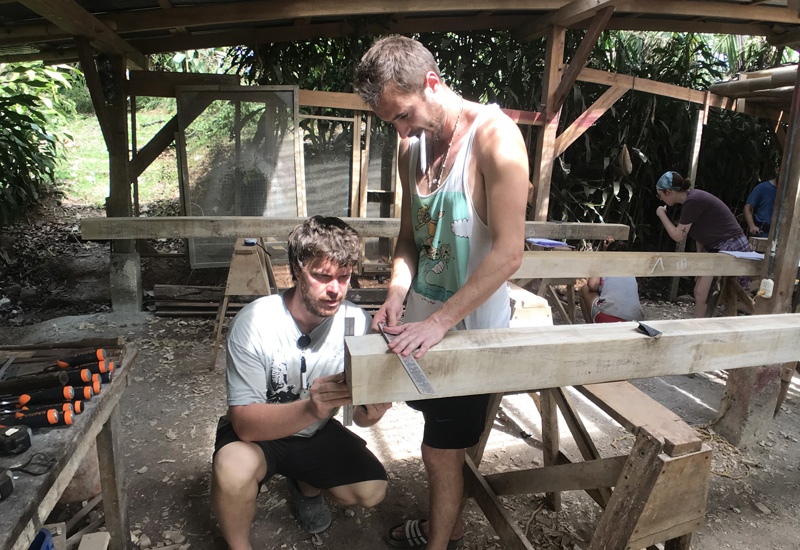
After five full days of learning and working, we were ready to put up the frame and we worked as a team to carry and lay out the timbers in order to lift the entire thing into place. Everything was a manageable size and, though a bit intimidating at first, it was all totally possible to put up together by hand. It was cool to see what you can accomplish with many hands, a bit of scaffolding, and a giant wooden hammer. Out of all of the joins, most were fine. A couple required a bit of extra work, but overall the structure went together fairly quickly.
I love that timber framing is like a giant puzzle that requires perfection in the joins. Natural building with clay is quite forgiving and I do like that aspect of it, but there’s something about accuracy and taking the time to make sure things are done to an excellent standard that I love as well. I feel like combining the precision of timber framing with the more forgiving methods of straw and clay is a wonderful balance and I’d love to design natural buildings that encompass both.
Because they’re in the tropics, the buildings at Rancho Mastatal don’t require insulation so the walls are made using the wattle and daub technique. I’d like to try a similar timber frame design but with straw bale walls so I’ll have to figure out how to account for the thickness of straw bales. I’m looking forward to the challenge and I can’t wait to get started on designing something! I feel like this course has given me a good knowledge base to build on and I’m not nearly as intimidated by the process now. Nic also passed on a huge collection of files, videos, and designs to look through and I’m excited to dive into that. I’m pretty clear on my passion for timber framing and now I just need to figure out where and when I can put it all into practice (I might have something exciting in the works for this year but it’s too early to say).
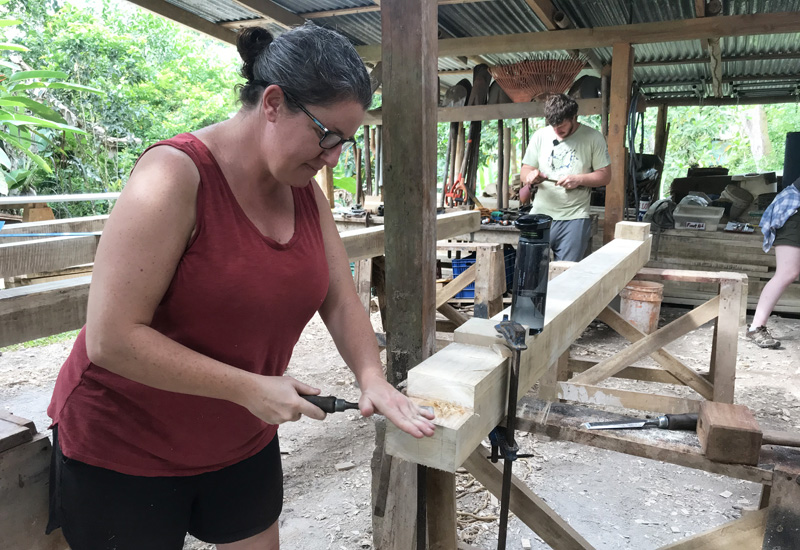
I feel like I was lucky with the timing of my arrival at Rancho Mastatal. The year-long apprenticeship programme had only started a week before and all of the apprentices were on the course. This meant seven apprentices and six students which could have been a weird dynamic, but it worked really well. I’ve lived on and passed through enough places to know that it can get tiring constantly meeting new people only to have to say goodbye in a week. Once you’re settled into a place and have your group of friends, it’s easy to switch off and it can take a lot of mental effort to stay open to new people knowing that they’ll soon be gone.
The apprentices were all very open and it was wonderful to hang out with them and the other students, even though it was brief. Everyone was laid back, interesting, friendly, and just super chill. I spent some of my free time carving spoons while another student worked on an etching project and eventually a couple of others joined in and we had our little craft corner going which was a lot of fun. The banter was just starting to get good right as I was leaving, but that’s just how it rolls. I really enjoyed the company of everyone I met at Rancho Mastatal and I’m excited for the experience the apprentices are going to have over this coming year – and maybe just a little bit jealous, too!
Foolishly, I didn’t take any photos of the food but it was really wonderful. We were served breakfast including eggs, fruit (the pineapples in Costa Rica are miraculously delicious), coffee, tea, and other goodies each morning and excellent lunches and dinners usually involving rice and beans and some other amazing thing. All of the food was simple, very tasty, and made with a focus on ingredients sourced locally from their land and the surrounding community. The team at Rancho Mastatal are quite into fermenting and we had a selection of things to choose from that were amazing. Something about fermentation has always given me the creeps, but I’m definitely on board now thanks to this experience.
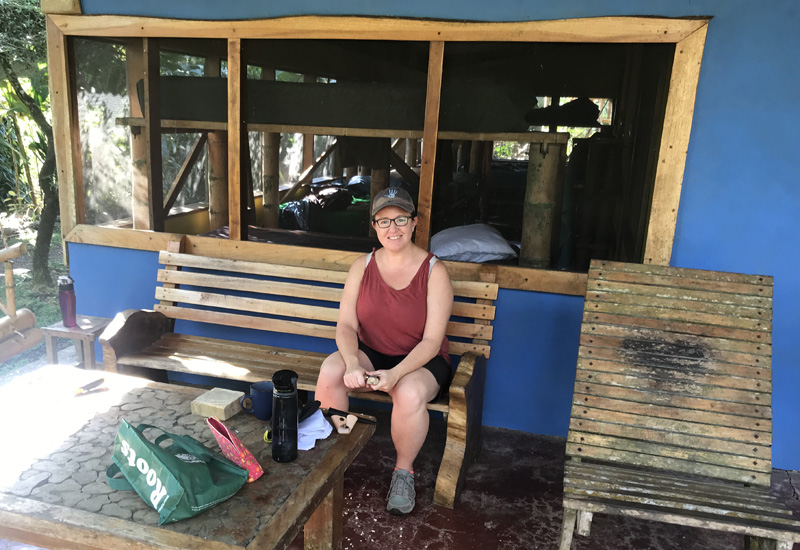
All of our meals were eaten around a huge table – actually three large tables pushed together end to end. It was nice to find myself sitting next to different people all the time and fun to chat with lots of guests, students, and residents during my time there. One thing that took me a bit by surprise happened shortly after sitting down to my first meal. Just after finding a space to sit, the people next to me took my hands and we all drifted into a silence. I wasn’t so sure what was happening but after a few seconds all was revealed – each dinner they have this ritual where everyone connects in silence for awhile and then people can speak about anything that they’d like to share. It sort of happens organically with folks speaking up in between sometimes long silences. It was totally new to me but I think it’s an awesome way of pausing, expressing gratitude even if you choose not to speak, and engaging in a simple community activity. I was very into it by the end!
The vibe at Rancho Mastatal is amazing and one of the best parts about the place is that there’s no internet! In order to get online we had to go down the street to the local library that was only open Monday to Friday between 9am and 5pm – basically the time we were learning and working. This meant that nobody was staring into their phones like zombies and people were truly present. It’s unusual these days to be without internet and it was really one of the highlights for me. I learned that my business won’t implode if I’m away from email for a few days and I enjoyed connecting with the people in front of me rather than sending constant messages to friends and family. I didn’t lose touch with anyone, my business survived, and I enjoyed the mental space that was freed up by disconnecting.
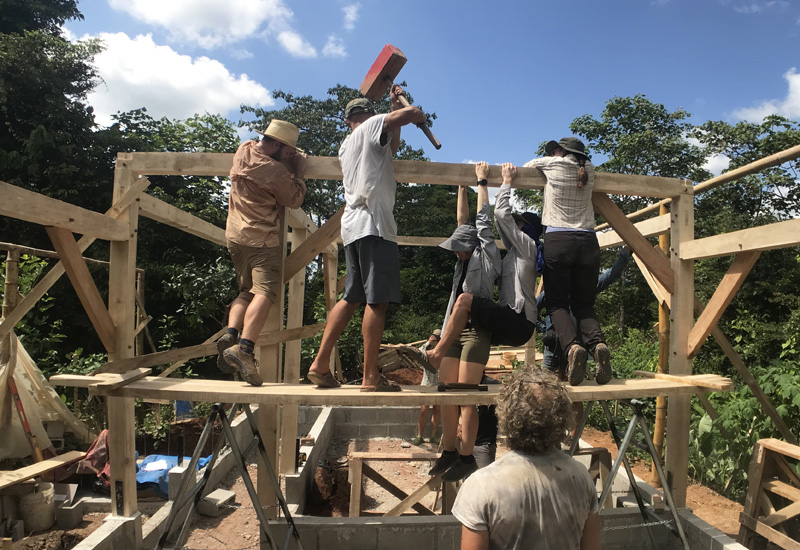
New Things I Did
- I took a course a couple of years ago in roundwood timber framing but this was the first time I’ve tried timber framing with square pieces of wood. Learning the Square Rule method demystified a lot of things for me and I think I’ve fallen deeply and madly in love with this type of building.
- I laid out my first timber under the close supervision and help of Nic and Ali. It was great to be able to look at the plans and eventually puzzle out how it all works. I was a bit confused at first but being given the opportunity to lay things out at my own pace allowed me the space and time to grasp the concepts.
- I finally learned how to properly sharpen a chisel and I was able to undo the damage I’d done on my poorly mistreated chisels. The key here is using a honing guide and alternating between sharpening the bevel and then flattening the back of the chisel. It was an eye opener!
- Despite having used a hand saw for probably thousands of cuts, Nic showed a really great technique for making sure cuts are square. It’s a key to timber framing and pretty simple once you get the hang of it.This was a great lesson in always keeping an open mind to learning because there are often better ways to do things, no matter how experienced you think you are.
- Drilling out the mortises using a mega drill with a 1″ bit was a new experience and sort of fun. I can’t imagine doing this part 100% by hand but I’m told it can be done with some special and very expensive tools. I love working with hand tools but this drill was pretty awesome.
- This was the first time I’ve helped put up this type of a timber frame. When I did my roundwood course, we erected the frames partially by hand but with a lot of help from a crane. Putting up the frame as a team and seeing what can be accomplished by hand was new and very cool. It was also the first time I’ve hammered in pegs and it was surprising to see how easily they go in when everything is done right and lines up correctly.
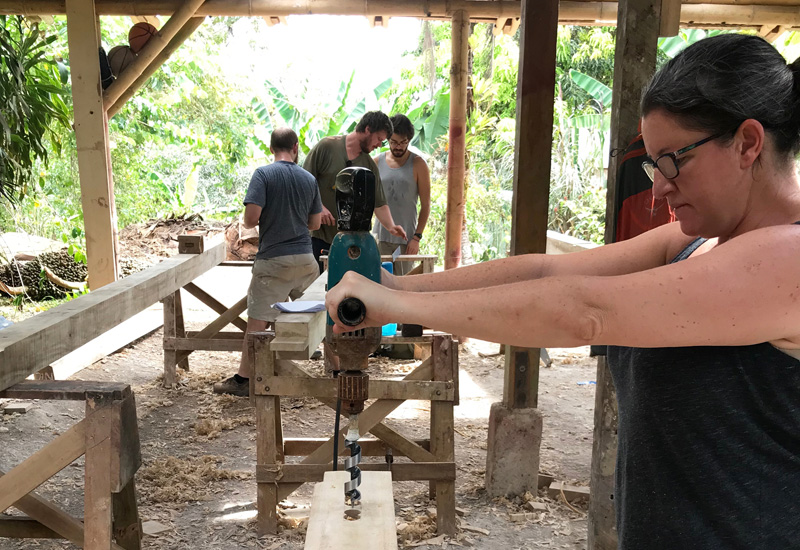
Highlights
So many!
- Meeting some very excellent people was one of the best parts. I was only there for a short period of time, but it was nice to be briefly surrounded by nice, engaged people who are all on very interesting life paths.
- Feeling empowered! I know there’s a lot more to timber framing than what we’ve learned here on this course and that there’s lots of practice ahead of me, but this week has demystified a lot of things. It’s left me feeling like I can push on with my own self-studies and figure a lot of things out on my own in time. Plus it’s wonderful to do things with hand tools and to see that you don’t need an expensive workshop of tools to be able to put a building up.
- Being at Rancho Mastatal and soaking up the awesome vibes was a big part of the experience. They have a really wonderful thing going on there and it was a pleasure to pop in for a short while to see what’s up. Walking around and seeing all of the beautiful buildings up close and in person was really cool after seeing them in photos and on video. It was also cool to see the progression of the buildings and the improvement from the earliest structures to now.
- The food and hospitality at Rancho Mastatal were also really wonderful. Every meal was amazing and I especially looked forward to the fabulous coffee in the morning and the fermented pop we had each day at lunch.
- Having Nic and Ali as teachers was a real treat. I loved the structure of the course and the way Nic demonstrated new skills to us as they were needed. He and Ali were always around to help out and they were both very patient and explained everything in a clear way. It was great to tap into their experience and knowledge!
- I loved the early to rise and early to bed flow of things and it was nice to see how they balance work, play, and self improvement. There’s a waterfall, a river, and a football field nearby for activities plus a little pub across the road. Unfortunately I missed a party by a day which would have been fun but I enjoyed the calm routine and life without hangovers.
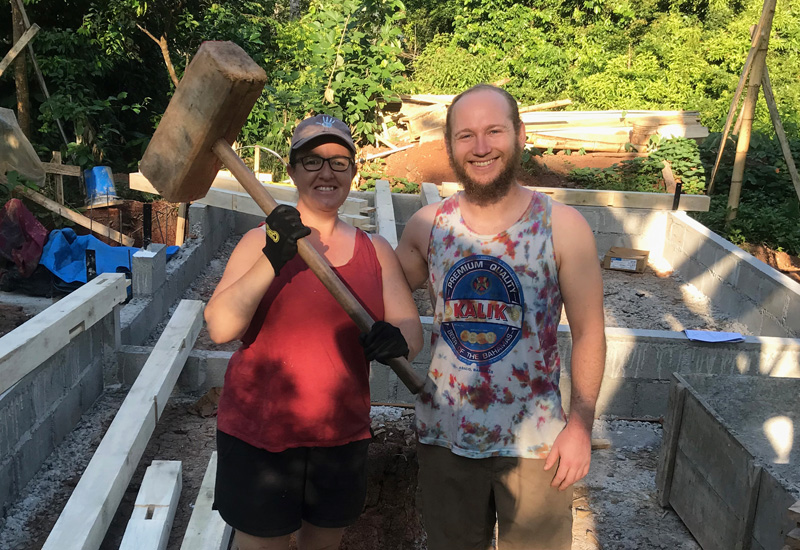
Challenges
This really was a pretty perfect experience all around, so these are a stretch!
- This wasn’t really a challenge mentally because I loved the need for precision, but making things perfect takes time and a lot of patience and getting the layout and joins right was definitely challenging! That line that’s off by a half millimeter? Do it again! It was interesting to see how accurate things need to be in order for the building to fit perfectly together.
- I’m not a massive fan of short term stays at places. I find that a major part of the experience of going to a place like this is connecting with like-minded people and I think that this is something that takes time. I felt like I was just really settling in after a week and then it was time to leave. I’d love to come back some day for a longer stay.
- This wasn’t a bad thing but our days were very full and the course was more tiring than I’d expected – my feet were surprisingly sore by the end of each day! It was great to dive into some physical work after a couple months of not doing much but I’d had grand plans of making house designs and practicing other types of joinery while I was there but instead I took naps. Another week there (at least) after the course would have been awesome.
- I somehow managed to injure myself with my chisel. Not my finger but my toe. Yes, that happened. I was stepping over a bag on the floor and somehow caught my toes on my chisel and bled all over the place. Fortunately it looked a lot worse than it actually was, but it wasn’t comfortable.
- The weather in the tropics is hot and humid – who would have guessed it? This wasn’t that much of an issue but it did make things uncomfortably sticky at times. But then I just decided to toughen up and it was all good.
- Working in inches was as ridiculous as I’d have expected it to be. Can someone please tell me why imperial measurements still exist? Ain’t nobody should be marking out 11/16ths. Ain’t nobody!
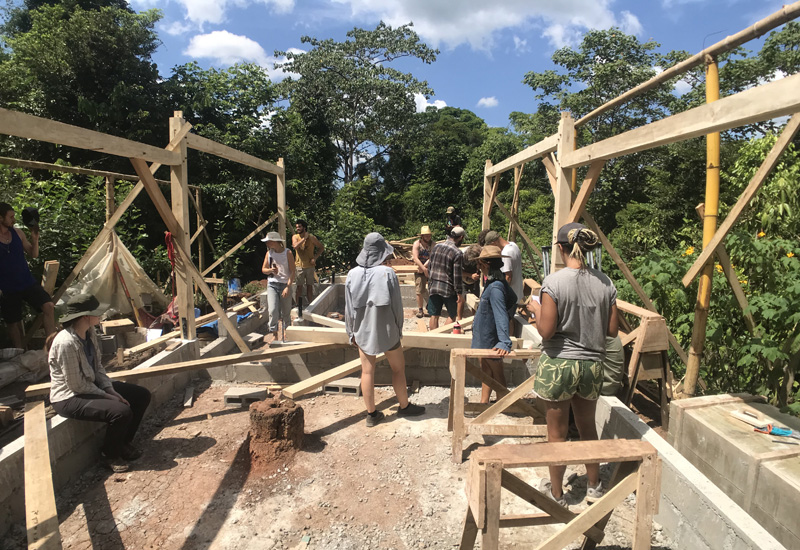
As you can probably guess, I loved the whole experience of being at Rancho Mastatal and learning timber framing. It was the best of both worlds – learning something I’ve grown passionate about and having an opportunity to experience a wonderful community. I’d 100% recommend a trip to this amazing place either as a guest, apprentice, intern, or for one of their courses. I don’t spend much time on the Americas side of the world but if I find myself in the neighbourhood again, I’ll be stopping by for a longer visit. There seems to be a lot of cool projects in Central and South America so maybe a longer trip is in order one of these days!


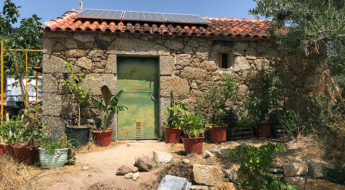
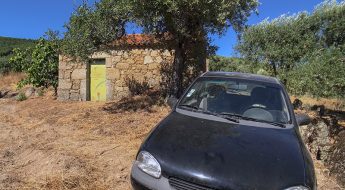
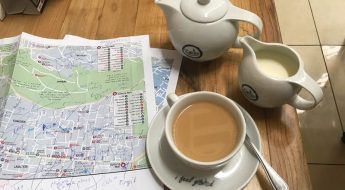
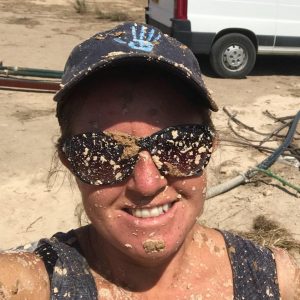
Leave a Comment